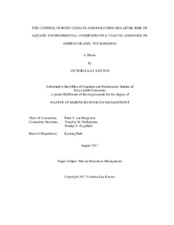| dc.contributor.advisor | van Hengstum, Peter J | |
| dc.creator | Keeton, Victoria Kay | |
| dc.date.accessioned | 2018-02-05T21:16:24Z | |
| dc.date.available | 2019-08-01T06:51:30Z | |
| dc.date.created | 2017-08 | |
| dc.date.issued | 2017-08-10 | |
| dc.date.submitted | August 2017 | |
| dc.identifier.uri | https://hdl.handle.net/1969.1/165916 | |
| dc.description.abstract | Andros Island is one of the largest island areas in the Bahamas, yet its paleoclimate and paleocological history remains poorly understood and largely based on inference from research on other Bahamian Islands. Understanding the Holocene history of Andros may provide insight into broader paleoenvironemental history of the region. Kemps Bay Bluehole is located on the eastern shore of South Andros Island. It is a terrestrial bluehole that is currently 4 m deep, 35 m in diameter, and located 51.3 m inland from the shoreline. Prior to 6500 Cal yr BP, microfossils (foraminifera; ostracodes) indicate that the basin transitioned from a polyhaline to oligohaline aquatic environment into an ephemeral pond, likely promoted by a regional trend toward drier conditions during the middle Holocene. Thereafter until 1000 Cal yrs BP, the site was dominated by lacustrine-like conditions, as indicated by the appearance of fresh to mesohaline microfossils (ostracodes: Cyprideis vidua; Perissocytheridea cribrosa; gyrogonites from charophytes), no foraminifera and deposition of carbonate marl. This environmental change was perhaps caused by concomitant groundwater table and Holocene sea-level rise that eventually inundated the floor of the sinkhole. In the last 1000 years, sedimentation shifted from carbonate marl to algal sapropel, and salinity in the basin increased based on the appearance of both foraminifera and ostracodes. During this time, it is also likely that Kemps Bay Blue Hole experienced intermittent oxygenation of bottom water based on abrupt oscillations in microfossil abundance versus absence. It is likely that regional precipitation changes combined with relative sea-level rise over the middle to late Holocene both contributed to environmental change in Kemps Bay Blue Hole. | en |
| dc.format.mimetype | application/pdf | |
| dc.language.iso | en | |
| dc.subject | paleoenvironmental reconstruction | en |
| dc.subject | ostracodes | en |
| dc.subject | foraminifera | en |
| dc.title | The Control of Both Climate and Holocene Sea-Level Rise on Aquatic Environmental Conditions in a Coastal Sinkhole on Andros Island, the Bahamas | en |
| dc.type | Thesis | en |
| thesis.degree.department | Marine Sciences | en |
| thesis.degree.discipline | Marine Resources Management | en |
| thesis.degree.grantor | Texas A & M University | en |
| thesis.degree.name | Master of Marine Resources Management | en |
| thesis.degree.level | Masters | en |
| dc.contributor.committeeMember | Dellapenna, Timothy M | |
| dc.contributor.committeeMember | Highfield, Wesley E | |
| dc.type.material | text | en |
| dc.date.updated | 2018-02-05T21:16:25Z | |
| local.embargo.terms | 2019-08-01 | |
| local.etdauthor.orcid | 0000-0003-1162-7928 | |


